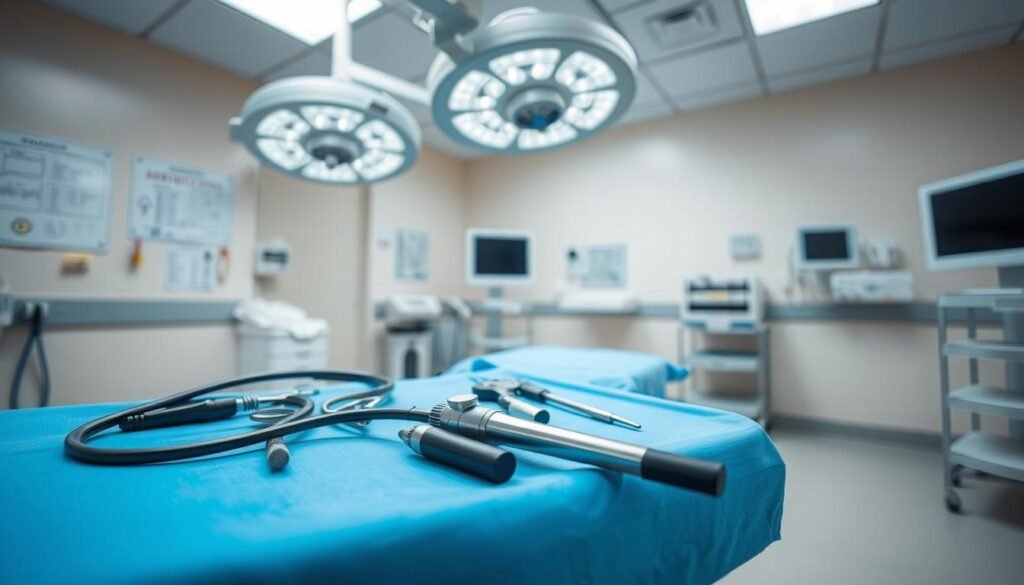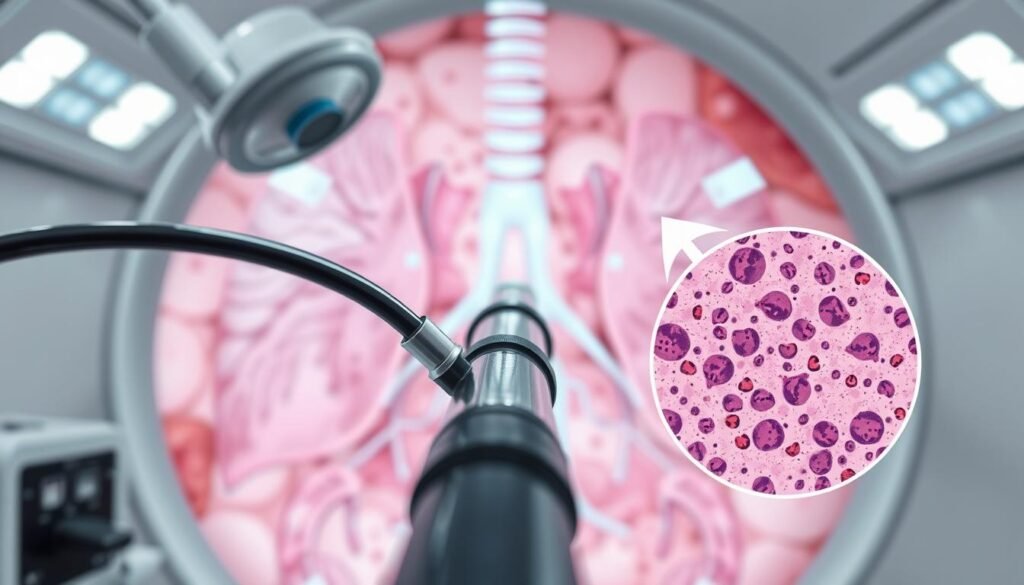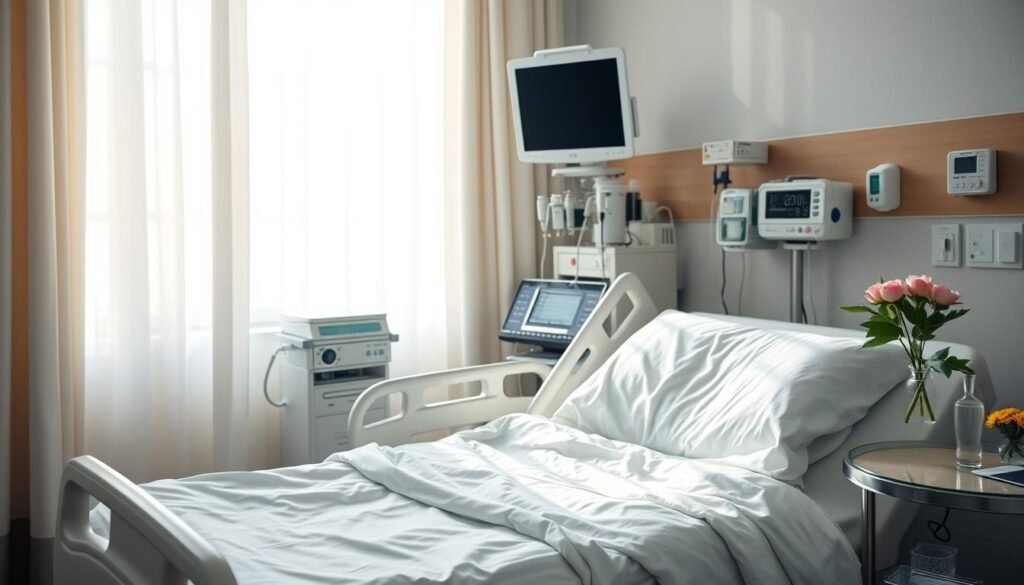Did you know lung cancer’s five-year survival rate is only 17% after finding out? But, if found early, this number jumps to over 70%. This shows how key it is to catch it early. A bronchoscopy plays a big role here. It helps doctors see inside the lungs to spot cancer. Knowing what to expect from a bronchoscopy helps patients make smart choices about their care.
The procedure is usually safe, but sometimes things can go wrong. These issues can be small or big. Being aware of the possible risks and upsides helps you talk better with your doctor. For more details, check out Cleveland Clinic’s guide on bronchoscopy.
Key Takeaways
- The survival rate for lung cancer significantly improves with early diagnosis.
- Bronchoscopy allows direct visualization of the lungs for accurate diagnosis.
- Complications are uncommon, but awareness of potential risks is crucial.
- Patients may require fasting before the procedure for safety.
- Understanding the bronchoscopy procedure can ease patient anxiety during diagnosis.
Understanding Bronchoscopy
Bronchoscopy is a minimally invasive way for doctors to look inside the lungs. They use a tool called a bronchoscope. This examination can reveal lung diseases, helping with diagnosis and treatment. Doctors called pulmonologists perform it to find problems like tumors, infections, or blockages.
Patients might feel more at ease during bronchoscopy. Doctors take tissue samples to check lung health. The procedure usually takes about 20 minutes, but it depends on the situation. Afterwards, people often go home the same day. But, some may need to stay overnight in the hospital.
Before bronchoscopy, patients should not eat or drink for several hours. Those taking blood thinners must talk to their doctors about stopping them. Although bronchoscopy is mostly safe, there are small risks. Patients might have minor bleeding or, rarely, serious lung infections.
Bronchoscopy is more than just for diagnosing; it helps in treatment too. It focuses on lung health. By understanding bronchoscopy, people can take an active part in their care. This procedure is key in addressing lung issues and improving health.
What is a Bronchoscopy Procedure?
A bronchoscopy is a key way to look at the lungs and breathing paths. Doctors use a bronchoscope, a tool with a camera and light. They put it through the nose or mouth into the trachea and lungs. This lets doctors see the airways well.
The bronchoscopy can take from 15 minutes to an hour, depending on the situation and the doctor’s methods. Sometimes it takes longer. This happens with complex cases, like lung tumors, or if more treatments are needed.
This procedure is not just for diagnosis. It also helps get tissue samples, clear blockages, and deal with problems directly. Usually, the whole thing, including prep and recovery, takes about four hours.
While bronchoscopies are safe, some risks exist. These include bleeding, infection, or in rare cases, a collapsed lung. After the procedure, some might feel throat discomfort or have a slight fever. These are common.
It’s a vital tool in finding and assessing lung tumors. It helps doctors figure out the best treatment plan.
For more information, visit this resource.
Why is Bronchoscopy Important in Lung Cancer?
Bronchoscopy is a key tool for lung cancer screening. It lets doctors see the bronchi directly. This allows for the early finding of lung cancer. Doctors can identify tumors that other scans might not show. It’s crucial for checking patients with symptoms like a constant cough or trouble breathing.
About 30% of lung cancer patients have central airway obstruction (CAO) when they are diagnosed. This shows how serious the condition often is early on. Around 1 in 3 people newly diagnosed with lung cancer has an endobronchial tumor. This highlights how important diagnostic procedures like bronchoscopy are in treating lung cancer.
Doing a bronchoscopy helps find out how big tumors are. This helps doctors create better treatment plans. Being able to see and assess tumors during this procedure can greatly improve a patient’s outlook. For example, those getting treated for CAO with bronchoscopy tend to live longer than those who don’t get treatment. This shows how bronchoscopy can really change lung cancer care.
The choice and planning for bronchoscopic treatments must be handled with care. This ensures that lung health risks are reduced. It also makes sure patients get the most benefit from bronchoscopy.
Bronchoscopy is crucial for diagnosing and treating lung cancer. It leads to better treatments and helps patients have better chances against this tough disease. To learn more about your lung cancer screening options, it’s important to keep up with research in this field.
Risks and Benefits of a Bronchoscopy in Lung Cancer Diagnosis
Understanding the risks and benefits of a bronchoscopy in lung cancer diagnosis is crucial. It helps patients make smart choices about their health. While safe, it’s key to know the potential complications that might happen.
Potential Risks
Some bronchoscopy risks include:
- Bleeding
- Infection
- Bronchial perforation
- Pneumothorax (collapsed lung)
These risks depend on the patient’s health and pre-existing conditions. Talking with healthcare providers is vital. It helps handle these risks and ensures patient safety.
Benefits for Early Detection
The main benefit of a bronchoscopy is it helps find lung cancer early. Doctors can see and take samples of suspicious areas. This leads to fast action. The benefits of bronchoscopy boost the chances for successful treatment.
With lung cancer, finding it early massively increases survival rates. This is important because about one-third of patients have central airway obstruction when diagnosed. Early detection through bronchoscopy is a key factor in battling lung cancer effectively.
Types of Bronchoscopy
Bronchoscopy is key in finding and treating lung problems with different bronchoscopy techniques. It has two main types: flexible bronchoscopy and rigid bronchoscopy. The choice depends on what the patient needs.
Flexible bronchoscopy is often chosen for its ease of use. It lets doctors check smaller airways with less discomfort. Patients stay awake, lightly sedated, for about 30 to 60 minutes. They get a numbing spray in the throat to stop gagging. It’s great for checking out stubborn coughs, infections, or odd findings on chest X-rays.
Rigid bronchoscopy is used less but is crucial for serious issues like major airway bleeding or taking out something stuck. This calls for general anesthesia because it’s more invasive. It gives better access to the airway in emergencies. The procedure takes about the same time but needs careful watching over during and after.
| Type of Bronchoscopy | Usage | Anesthesia Type | Duration |
|---|---|---|---|
| Flexible Bronchoscopy | Diagnosing lung diseases, persistent coughs, infections | Sedated but awake | 30 – 60 minutes |
| Rigid Bronchoscopy | Severe airway bleeding, foreign object removal | General anesthesia | 30 – 60 minutes |
Both flexible bronchoscopy and rigid bronchoscopy are crucial tools for doctors. They help look at and treat tough lung issues. By understanding these bronchoscopy techniques, patients can get ready for what type of care they might need.
Preparing for a Bronchoscopy
Making good preparations for a bronchoscopy can ensure it’s both safe and successful. It’s key for patients to follow certain rules. These include fasting guidelines and medication restrictions. Knowing and following these rules will help make the procedure go smoothly.
Medication and Fasting Instructions
Patients must not eat for 4 to 8 hours before the test, as doctors advise. Not eating helps avoid problems during the bronchoscopy. It’s crucial to talk about all medicines you’re taking. This includes anything from the drugstore or health supplements. Some medicines, like those that prevent blood clots, might have to be stopped for a while. This helps lower the chance of bleeding. Always listen carefully to what your healthcare provider tells you about how to prepare.
It’s also a good time to get your papers in order. Make sure you have your ID and a note listing all your medicines. It can really help to bring someone with you for support. It can make you feel less anxious. For more details on what to expect, patients can look at this helpful resource.
By sticking to the fasting guidelines and the medication restrictions, you make your bronchoscopy safer and more likely to work well.

What to Expect During the Procedure
Individuals undergoing bronchoscopy will experience various stages. They are sedated to stay calm yet conscious while the procedure occurs. This makes the experience better, reducing any discomfort.
Duration and Anesthesia Options
The whole process, including prep and recovery, usually takes about four hours. The bronchoscopy itself lasts from 30 to 60 minutes. It depends on what needs to be assessed. Choices of anesthesia range from general to local with sedation, depending on the case’s complexity and the patient’s health.
Monitors are used to watch vital signs, keeping the patient safe. Bleeding, often minor, may occur but usually stops on its own. Severe complications are rare.
Patients should not eat or drink for 4 to 8 hours before the bronchoscopy. Those curious about lung issues may find it useful to learn about lung cancer symptoms versus COPD.
Tissue Sampling and Diagnosis
Tissue sampling is a key part of bronchoscopy. It allows for getting biopsies from lung tissue. These samples are crucial for accurate diagnostic tests to find cancer cells. In lung cancer cases, effective lung cancer assessment leads to timely, right treatment for each person.
Bronchoscopy does more than just show images. It lets doctors get tissue samples directly. For example, using bronchial washings, brushings, and biopsies can confirm a diagnosis in over 60% of cases. This approach greatly improves the chances of a correct diagnosis. When it comes to central endobronchial tumors, the success rate of endobronchial biopsies is about 90%. This shows how vital precise tissue sampling is for spotting lung cancer.
Transbronchial needle aspiration (TBNA) and bronchoalveolar lavage (BAL) boost bronchoscopy’s ability to diagnose. BAL finds about 30% of peripheral lung tumors, and the rate goes up to 56% with other tests. BAL is especially good at finding certain cancers, like bronchoalveolar cell carcinoma.

Even with high accuracy, some challenges remain. For tumors inside the wall of the lung rather than on the surface, the success rate of bronchoscopy falls to 55%. The main problems happen when tumors are out of the tool’s sight. Knowing the details of tissue sampling and readying for diagnosis challenges is key for successful lung cancer checks.
| Technique | Diagnostic Yield | Recommended Use |
|---|---|---|
| Endobronchial Biopsy | ~90% | Central endobronchial lesions |
| Bronchoalveolar Lavage (BAL) | ~30% (increases to 56% with combination) | Pleural lesions and peripheral lung assessment |
| Transbronchial Needle Aspiration (TBNA) | Varies | Recommended for submucosal lesions |
| Bronchial Washings and Brushings | Part of combined approaches | Visible central lesions |
Potential Complications of Bronchoscopy
Bronchoscopy is a useful tool but comes with risks. Knowing about bronchoscopic complications helps patients be ready. Complications are split into minor and major types, each with different impacts.
Minor vs. Major Complications
Minor complications can include a sore throat or brief bleeding. These are usually short-term but uncomfortable. On the serious side, we have major complications. These include things like bronchial perforation and pneumothorax. They can make hospital stays longer or need extra treatment. About 3.0% of lung cancer diagnostics lead to pulmonary infections, with pneumonia being the most usual.
The type and size of lesions can increase complication risks. Bigger endobronchial lesions raise the chance of infections. For example, people with small cell lung cancer are more likely to have these issues.
Managing Risks Based on Patient Health
Assessing each person’s health is crucial in managing risks from bronchoscopy. Health status can affect the chance of both minor and major complications. Doctors consider respiratory conditions, allergies, and past reactions to anesthetics. Working closely with patients helps adjust medications before the procedure.
Patients should follow fasting instructions before the procedure and discuss any health worries. Being proactive improves safety and reduces the chance of complications.
| Type of Complication | Incidence Rate | Common Risk Factors |
|---|---|---|
| Minor Complications | Low (e.g., sore throat, mild bleeding) | General health status, anxiety |
| Major Complications | 0.2-5.2% | Large endobronchial lesions, advanced cancer stage |
| Infections | 3.0% (with pneumonia as primary concern) | Presence of lesions, lung cancer type |
Patient Recovery After Bronchoscopy
Recovery after a bronchoscopy is key for good health and outcomes. After the procedure, patients rest in a special area. Healthcare professionals watch them for any issues. They check vital signs as sedation fades.
A sore throat, mild cough, or hoarseness may happen, but these symptoms are often short-lived. Patients are advised not to eat or drink until they can swallow properly. This is to prevent choking.
Once sedation ends, many people quickly get back to their daily routine. They usually face few limits in their activities after 24 hours. Yet, it’s important for someone to escort them home. They should not be left alone for a day post-procedure.
| Recovery Aspect | Details |
|---|---|
| Duration of Procedure | 20-30 minutes |
| Overall Appointment Time | At least 2 hours |
| Eating/Drinking Restrictions | 2 hours post-procedure |
| Companion Required | Yes, for post-procedure care |
| Return to Normal Activities | Most can resume within 24 hours |
Following the care guidelines after bronchoscopy greatly improves recovery. These steps help avoid problems and ensure patient comfort.

Conclusion
Bronchoscopy is key in diagnosing lung cancer. Since 1897, it has evolved a lot. Today, tools like endobronchial ultrasound (EBUS) help doctors find and treat airway diseases better. Knowing about bronchoscopy’s risks and benefits shows how it helps catch cancer early. This early diagnosis can improve how well treatments work for lung cancer patients.
When patients talk to their doctors about bronchoscopy, they should feel confident. This conversation helps patients understand the procedure. It makes them feel more secure about what’s coming. The insights from bronchoscopy heavily influence a patient’s treatment path. So, it plays a crucial role in fighting lung cancer.
As medicine gets better, bronchoscopy stays important for diagnosing accurately and treating effectively. Thanks to tech and method advancements, patients can expect care that fits their unique health needs. This care aims to reduce complications as much as possible.